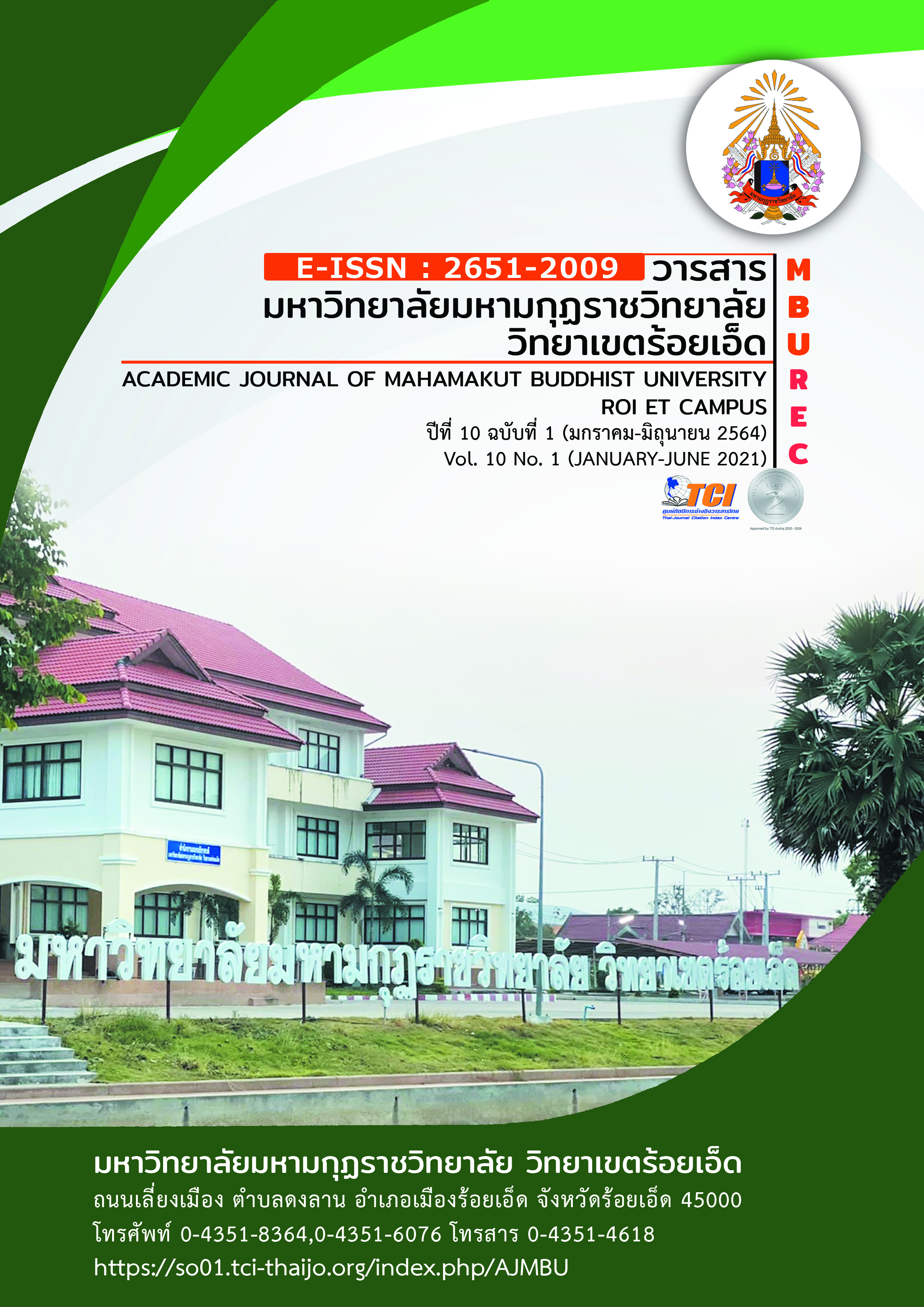The Development of a Model for Prevention and Resolution of the Conflicts Caused by the Juveniles in the Twentieth Century with Buddhist Methodology
Main Article Content
Abstract
The objective of the research article were 1) to create and develop a form of prevention and problem solving of Thai youth in the 21st century, 1) to assess the effectiveness and to experiment with the consistency of the prevention and problem-solving patterns of Thai youth in the 21st century. the researchers developed with empirical data. research Use a mixed research methodology Between Quantitative research and Multi-case study research It is a parallel operation. In the same research, both quantitative from the questionnaire, qualitatively from interviews with stakeholders, and study the evidence which links data from open-ended queries to analyze and discuss the results in conjunction with qualitative data collection areas and targets used for this research The researchers conducted a specific study of the data into three groups, administrators and teachers. 2) Youth students in educational institutions affiliated with the Office of secondary education area and the Northeast District Vocational Education Commission and 3) Experts and qualified. Experienced youth operations 20 photos/person, The tool used in this research is an open-ended questionnaire, a scaling type query, using Delphi technical research.
The results showed that; 1. the creation and development of the prevention and problem-solving model of Thai youth in the 21st century consisted of factors that contributed to the controversy of youth. There are two main causes: personal or internal factors: the cause of the youth itself and the environment or external factors. 1) family institution, 2) environment, 3) educational institutions, 4) friends, brothers, 5) justices and related laws and 6) social media. In 2014, the Thai Public Company Limited 21st Century Thai Public It found that there were 8 guidelines: 1) Guidelines for preventing controversy by individuals (youths), 2) guidelines to prevent dispute problems by families or parents, 3) guidelines for preventing controversy by society and the environment, 4) guidelines for preventing controversy by institutions, 5) guidelines for preventing controversy by the judicial and legal process, 6) guidelines for preventing controversy by social media, 7) guidelines for supporting, promoting and rehabilitating after a controversial event, 8) guidelines for preventing controversy by Buddhist-based. 2. The Researchers found that the researchers developed a more effective and consistent approach to preventing and resolving the controversy of Thai youth in the 21st century. It was found that the pre-trial level was statistically significantly higher than at .05.
Article Details
References
จิรเดช เกตุประยูร. (2556). วิธีระงับความรุนแรงตามแนวคิดในทางพุทธศาสนาเถรวาท. รายงานการวิจัย. มหาวิทยาลัยเทคโนโลยีราชมงคลรัตนโกสินทร์.
นพดล กรรณิกา. (2552). สถานการณ์การใช้ความรุนแรงในกลุ่มเด็กและเยาวชน. สืบค้นเมื่อ 9 ตุลาคม 2560. จาก http://www.ryt9.com/s/abcp/524293
พรชัย ขันตี. (2553). ทฤษฎีอาชญาวิทยา : หลักการงานวิจัยและนโยบายประยุกต์. กรุงเทพมหานคร : สุเนตรฟิล์ม.
พระพรหมคุณาภรณ์ (ป.อ.ปยุตฺโต). (2548). ศึกษาฝึกฝนพัฒนาตน ให้สูงสุด. พิมพ์ครั้งที่ 2. กรุงเทพมหานคร : อมรินทร์.
พระมหามนตรี ประทุมวรรณ. (2551). การนำหลักธรรมทางพระพุทธศาสนามาใช้เป็นมาตรการป้องกันและลดวิกฤตปัญหานักเรียนตีกัน. ดุษฎีนิพนธ์ปรัชญาดุษฎีบัณฑิต. บัณฑิตวิทยาลัย : มหาวิทยาลัยราชภัฎสวนดุสิต.
พระสรวิชญ์ อภิปญฺโญ และนิเวศน์ วงศ์สุวรรณ. (2553). บทบาทของพระสงฆ์ในการพัฒนาคุณธรรมจริยธรรมแก่เยาวชน ตำบลหนองหลัก อำเภอไชยวาน จังหวัดอุดรธานี. Journal of Buddhist Education and Research. 5(2). 253-264.
พระอนุสรณ์ กิตฺติวณฺโณ. (2561). การปฏิรูปการศึกษาให้ถูกทางตามหลักวิถีพุทธ. วารสารวิชาการธรรมทรรศน์. 18(1). 237-248.
ยิ่งภัสสร พิมพิสัย. (2555). ศึกษาสภาพปัญหาและแนวทางแก้ไขปัญหาการทะเลาะวิวาทของนักเรียนอาชีวศึกษาในเขตกรุงเทพมหานครและปริมณฑล. รายงานวิจัย. วิทยาลัยเทคนิคดอนเมือง.
วิชา มหาคุณ. (2551). การป้องกันและแก้ไขปัญหายาเสพติดการสร้างเครือข่าย-การส่งต่อ-การติดตามและประเมินผล เด็กเยาวชน ครอบครัว ชุมชนและสังคม. กรุงเทพมหานคร : จุฬาลงกรณ์มหาวิทยาลัย.
สมทรัพย์ สุขอนันต์. (2546). วัยใส วัยเสี่ยง วัยวุ่น วัยแห่งความเสี่ยง เอกสารในการอบรม เรื่องแนวทางด้านจิตวิทยาชุมชนเพื่อป้องกันปัญหาวัยรุ่น : การให้ความรู้ผู้ปกครองเพื่อป้องกันปัญหาวัยรุ่น. กรุงเทพมหานคร : มหาวิทยาลัยศิลปากร.
สำนักงานคณะกรรมการพัฒนาเศรษฐกิจและสังคมแห่งชาติ. (2560). แผนพัฒนาเศรษฐกิจและสังคมแห่งชาติ ฉบับที่ 12 ( พ.ศ. 2560–2564). กรุงเทพมหานคร : สำนักนายกรัฐมนตรี.
สุดาพร สินประสงค์. (2550). สาเหตุและแนวทางแก้ไขปัญหาการทะเลาะวิวาทของนักเรียน นักศึกษาระดับอาชีวศึกษาประเภทช่างอุตสาหกรรมในเขตกรุงเทพมหานคร. วิทยานิพนธ์ปริญญาครุศาสตรมหาบัณฑิต. มหาวิทยาลัยราชภัฎธนบุรี.
โสภา ชูพิกุลชัย ชปีลมันท์. (2548). บุคลิกภาพและพัฒนาการแนวโน้มสู่การมีพฤติกรรมปกติหรือพฤติกรรมเบี่ยงเบนของเด็กและเยาวชน. บัณฑิตวิทยาลัย : มหาวิทยาลัยราชภัฎสวนดุสิต.


